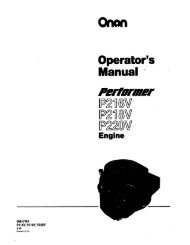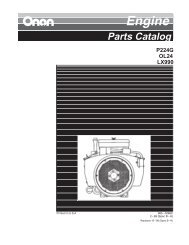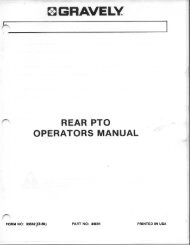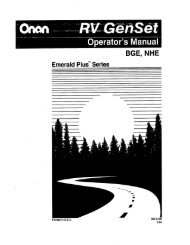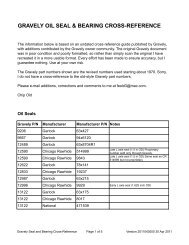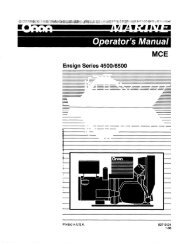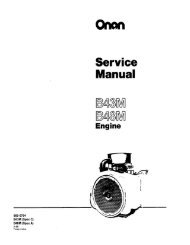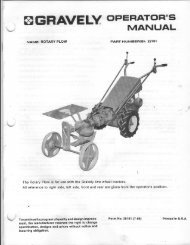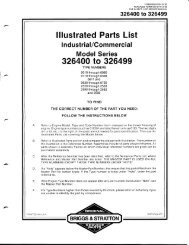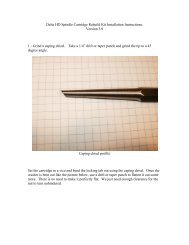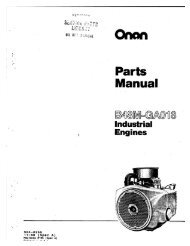272144 Vanguard Twin Cylinder OHV BRIGGS & STRATTON.pdf
272144 Vanguard Twin Cylinder OHV BRIGGS & STRATTON.pdf
272144 Vanguard Twin Cylinder OHV BRIGGS & STRATTON.pdf
Create successful ePaper yourself
Turn your PDF publications into a flip-book with our unique Google optimized e-Paper software.
A<br />
<br />
<br />
<br />
<br />
Fig. 14<br />
<br />
Fig. 15<br />
<br />
<br />
NOTE: Service replacement diode harnesses are<br />
available. Use resin core solder when<br />
installing new harness. Use shrink tubing or<br />
tape all connections.<br />
DO NOT USE CRIMP CONNECTORS.<br />
Dual Circuit Alternator<br />
Dual circuit alternators use a polarized plug with two<br />
pins. One pin provides DC current for charging the<br />
battery, the second pin is an independent AC circuit<br />
for headlights.<br />
Current for lights is available when the engine is<br />
running. The output varies with engine speed, so<br />
brightness of the lights changes with engine speed.<br />
12 volt lights with a total rating of 60 to 100 watts<br />
may be used. With lights rated at 70 watts, the<br />
voltage rises from 8 volts @ 2400 RPM to 12 volts<br />
at 3600 RPM. Since the battery is not used for the<br />
lights, the lights are available even if the battery is<br />
disconnected or removed.<br />
Current from the DC side of the alternator is<br />
unregulated and is rated at 3 amps. The output rises<br />
from 2 amps @ 2400 RPM to 3 amps @ 3600 RPM.<br />
1. Stator assembly (1), Fig. 15.<br />
2. RED lead from stator (2), DC output for charging<br />
battery.<br />
3. BLACK lead from stator (3), AC output for<br />
lighting circuit.<br />
4. DIODE encased at connector (4).<br />
5. WHITE lead (5) for AC lighting circuit.<br />
6. RED lead (6) for DC charging circuit.<br />
DC Output Test<br />
NOTE: The battery MUST be in good condition to<br />
perform this test.<br />
1. Insert RED test lead into 10A receptacle in meter.<br />
2. Insert BLACK test lead into COM receptacle in<br />
meter.<br />
3. Rotate selector to A== (DC AMPS) position.<br />
4. Attach RED test lead clip (1) to DC output pin (6)<br />
in connector (4), Fig. 16.<br />
Ì ÌÌ <br />
<br />
<br />
Fig. 16<br />
<br />
<br />
NOTE: The raised rib on the connector or the RED<br />
wire (3) indicates the DC output pin side.<br />
The AC pin (5) is not used for this test.<br />
5. Attach BLACK test lead clip (2) to POSITIVE (+)<br />
battery terminal.<br />
6. With engine running at 3600 RPM output should<br />
be between 2 - 4 amps DC.<br />
NOTE: The output will vary with the battery voltage.<br />
At maximum battery voltage the output will<br />
be approximately 2 amps.<br />
7. If NO or LOW output is found, test diode.<br />
37




